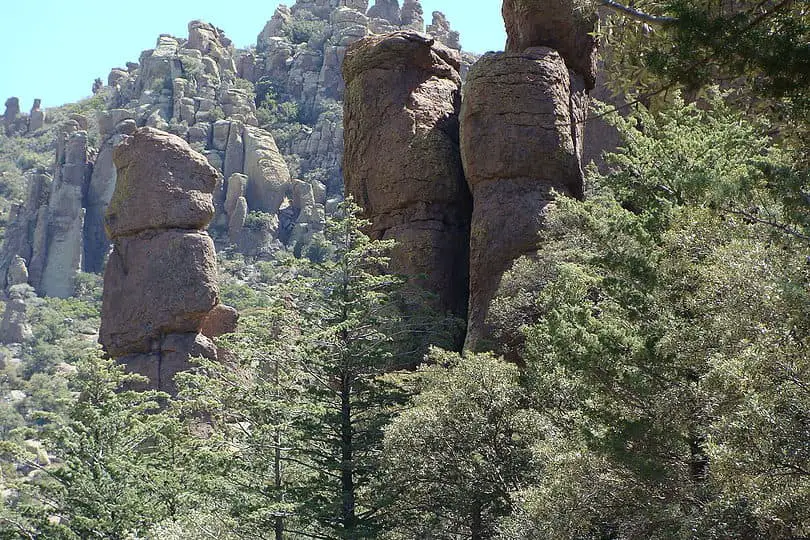The Arizona cypress tree (Hesperocyparis arizonica) is a conifer native to the arid landscapes of the southwestern United States and northern Mexico. With its striking blue-green foliage and ability to thrive in hot, dry conditions, this tree has become a popular ornamental plant far beyond its natural range But where did this iconic desert tree come from? Let’s take a look at the origin story of the Arizona cypress
A True Southwestern Native
The Arizona cypress is endemic to the Southwestern United States and Mexico. In the U.S, its native range consists of small, scattered populations in southeastern Arizona, southwestern New Mexico, and western Texas. It reaches its northern limits around the Mogollon Rim in Arizona The tree grows at elevations between 1,000-1,500 meters in the U.S. and up to 2,200 meters in the northern Mexican states of Chihuahua, Coahuila, Durango, Tamaulipas, and Zacatecas.
This range means the Arizona cypress is well-adapted to hot, dry environments It thrives in areas too arid for many other conifers but receives enough winter precipitation to sustain it The tree tends to grow in canyons and on rocky slopes, indicating its tolerance for poor, well-drained soils. Its natural habitat is diverse, including pine-oak woodlands, desert grasslands, and tropical deciduous forests.
Overall, the Arizona cypress is a true southwestern native. Its limited range reflects its adaptation to the unique conditions of this region. Scientists consider it a neoendemic conifer species that developed locally from related cypress species.
A Living Fossil
Fossil evidence indicates the Arizona cypress has existed in some form for over 20 million years. Remains found in the Miocene deposits of Nevada closely resemble modern Arizona cypress trees. This suggests the species has remained relatively unchanged since the Miocene epoch.
The longevity of the Arizona cypress gives it “living fossil” status. Many other tree species have come and gone over 20 million years, but this cypress continues to thrive in its native habitat. Its persistence indicates an impressive ability to survive major climatic shifts like ice ages. Even as its range contracted during cooler and wetter periods, the Arizona cypress endured in refugia until the climate improved.
While it has likely evolved some over millions of years, the archeological record confirms the Arizona cypress’ consistency as a species. Its long lifespan is a testament to the resilience of this desert conifer.
Developing in Isolation
Several factors point to the Arizona cypress evolving independently from related cypress species over a long period of time. This isolation allowed it to develop unique adaptive traits that set it apart from other cypresses.
First, the Arizona cypress’ limited range suggests a long separation from other cypresses like the Cuyamaca cypress and Tecate cypress in California. It only exists in the desert Southwest, not the wetter, coastal regions further west. This distribution indicates the Arizona cypress became isolated inland early on.
Second, the Arizona cypress’ heat and drought tolerance distinguish it from coastal cypress species. It likely evolved these adaptations in response to the increasingly arid conditions inland. Isolation from competition allowed it to specialize in its dry, mountainous niche away from other cypresses.
Finally, the Arizona cypress exhibits some genetic distinction from its nearest relatives. While still closely related, its genetic divergence points to long periods of separation. Taken together, these clues indicate the Arizona cypress speciated in the desert Southwest millions of years ago and has remained there ever since.
A Cypress Perfectly Adapted to the Desert
From its ancient beginnings to today, the Arizona cypress has become a textbook example of an arid-adapted conifer. It overcame the challenges of its environment through superb drought resistance and an ability to thrive in rocky, nutrient-poor soils. This tree continues to grow happily in the same desert landscapes that it evolved in over 20 million years ago.
Next time you see an Arizona cypress, take a moment to appreciate this living piece of history. Its persistence is a remarkable story of survival through isolation and adverse conditions. This iconic desert tree remains a perfectly adapted native of the arid Southwest.

Which Tree is Right for Me?
With the option of ordering either standard or semi-dwarf trees and either bare-root or potted, be sure to consider the benefits of each option when deciding which is best for you.
- Also functions as a shade tree
- Can be planted farther from compatible pollinator
- Fills a larger space
- Easier to harvest fruit
- Bears fruit sooner
- Fits in a smaller space
Carolina Sapphire Arizona Cypress – Cupressus arizonica
FAQ
Where is Arizona cypress native to?
Where did the cypress tree originate?
Is Arizona cypress a true cypress?
